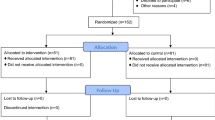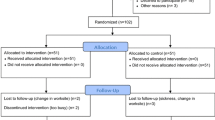Abstract
The incidence of musculoskeletal injuries associated with computer use is increasing. Education has been advocated as a prevention method for reducing the incidence and severity of these injuries. Although the inclusion of education in prevention programs has become a popular practice, its efficacy is poorly defined. The present study was designed to investigate the efficacy of worker education programs in preventing musculoskeletal injuries in a population of reservation center employees who spend the majority of their workdays, using the computer. Participants were randomly assigned to one of three study groups (control, traditional education, or participatory education). Data collection utilized self-report surveys and observational checklists to collect data prior to intervention and at approximately 3, 6, and 12 months post intervention. Those who received education reported less pain/discomfort and psychosocial work stress following the intervention than those who did not receive education. There was no indication that the differences in reported pain/discomfort or psychosocial work stress were related to better work area configuration or improved worker postures. Those workers in the participatory education intervention group reported a significantly better perception of their health status than those in the control group or the traditional education group. It is unclear if the method of intervention was solely responsible for the higher rating.
Similar content being viewed by others
REFERENCES
Dawson DM. Entrapment neuropathies of the upper extremity. New Engl J Med 1993; 329: 2013–2018.
Hales TR, Sauter SL, Peterson MR, Fine LJ, Putz-Anderson V, Schleifer LR, Ochs TT, Bernard BP. Musculoskeletal disorders among visual display terminal users in a telecommunications company. Ergonomics 1994; 37: 1603–1621.
Maizlish N, Rudolph L, Dervin K, Sankaranarayan M. Surveillance and prevention of work-related carpal tunnel syndrome: An application of the Sentinel Events Notification System for Occupational Risks. Am J Ind Med 1995; 27(5): 715–729.
Bernard B, Sauter SL, Fine LJ, Peterson MR, Hales TR. Psychosocial and work organization risk factors for cumulative trauma disorders in the hands and wrists of newspaper employees. Scan J Work Environ Health 1992; 18(Suppl 2): 119–120.
Louis D. Cumulative trauma disorders. J Hand Surg 1987; 12A: 823–825.
Chatterjee DS. Repetitive strain injury–a recent review. J Soc Occup Med 1987; 37: 100–105.
US Department of Labor, Bureau of Labor Statistics. Occupational injuries and illnesses in the United States by injury, 1981. Washington, DC: US Government Printing Office, 1983.
US Department of Labor, Bureau of Labor Statistics. Occupational injuries and illnesses in the United States by injury, 1991. Washington, DC: US Government Printing Office, 1993.
Brogmus GE, Sorock GS, Webster BS. Recent trends in work-related cumulative trauma disorders of the upper extremities in the United States: An evaluation of possible reasons. JOEM 1996; 38(4): 401–411.
Sanders RL, Shultz MR. Education and training. In: King PM, ed. Sourcebook of occupational rehabilitation. New York: Plenum Press, 1998, pp. 109–126.
Van Akkerveeken PF. Teaching aspects. Ergonomics 1985; 28: 371–377.
McCauley M. The effect of body mechanics instruction on work performance among young workers. Am J Occup Ther 1990; 44: 402–407.
Rempel D. Ergonomics–prevention of work-related musculoskeletal disorders. West J Med 1992; 156: 409–410.
King PM. A program planning model for injury prevention. Occup Ther Pract 1993; 4(4): 47–53.
Stokols D, Pelletier KR, Fielding JE. The ecology of work and health: Research and policy directions for the promotion of employee health. Health Educ Q 1996; 23: 137–158.
Lindell MK. Motivational and organizational factors affecting implementation of worker safety training. Occup Med 1994; 9: 211–240.
Isernhagen SJ. Back schools. In: Isernhagen SJ, ed. Work injury: Management and prevention. Rockville: Aspen, 1988, pp. 19–28.
Nordin M, Cedraschi C, Balague F, Roux EB. Back schools in prevention of chronicity. Ballieres Clin Rheumatol1992; 6(3): 685–703.
Woodruff DS, Walsh DA. Research in adult learning: The individual. Gerentologist 1975; 15: 424–430.
Robins T, Hugentobler M, Kaminski M, Klitzman S. Implementation of the federal hazard communication standard: Does training work? J Occup Med 1990; 32: 1133–1140.
Weinger M, Lyons M. Problem-solving in the fields: An action oriented approach to farmworker education about pesticides. Am J Ind Med 1992; 22: 677–690.
Wallerstein N, Weinger M. Health and safety education for worker empowerment. Am J Ind Med 1992; 22: 619–635.
Anderson GBJ. Concepts in prevention. In: Pope MH, ed. Occupational low back pain. New York: Praeger, 1984, pp. 211–216.
Brown KC, Sirles AT, Hilyer JC, Thomas MJ. Cost effectiveness of a back school intervention for municipal employees. Spine 1992; 17(10): 1224–1228.
Versloot JM, Rozeman A, Van Son AM, Van Akkerveeken PF. The cost-effectiveness of a back school program in industry: A longitudinal controlled field study. Spine 1992; 17: 22–27.
Lahad A, Matter AD, Berg, AO, Deyo RA. The effectiveness of four interventions for the prevention of low back pain. J Am Med Assoc 1994; 272: 1286–1291.
Leamon TB. Research to reality: A critical review of the validity of various criteria for the prevention of occupationally induced low back pain disability. Ergonomics 1994; 37: 1959–1974.
DeFabio R. Efficacy of comprehensive rehabilitation programs and back school for patients with low back pain: A meta-analysis. Phys Ther 1995; 75(10): 865–878.
LeClaire R, Esdiale JM, Suissa S, Rossignol M, Proulx R, Dupuis M. Back school in a first episode of compensated acute low back pain: A clinical trial to assess efficacy and prevent relapse. Arch Phys Med Rehab1996; 77: 673–679.
Berwick D, Budman S, Feldstein M. No clinical effect of back schools in an HMO: A randomized prospective trial. Spine 1989; 14(3): 338–344.
Dehlin O, Hedenrud B, Horal J. Back symptoms in nursing aides in a geriatric hospital. Scand J Rehabil Med 1976; 8: 47–53.
Scholey M. Back stress: The effects of training nurses to lift patients in a clinical situation. Int J Nurs Stud 1983; 20(1): 1–13.
Snook SH. Approaches to the control of back pain in industry: Job design, job placement and education/ training. Occup Med 1988; 3(1): 45–59.
Stubbs DA, Buckle PW, Hudson MP, Rivers PM. Back pain in the nursing profession: The effectiveness of training. Ergonomics 1983; 26(8): 767–779.
Gotsch AR, Weidner BL. Strategies for evaluating the effectiveness of training programs. J Occup Med 1994; 9(2): 171–188.
Bohr PC, Barrett NE. Assessing the efficacy of education programs for musculoskeletal work injury prevention. J Occup Rehabil 1997; 4(4): 239–247.
Kuorinka I, Jonsson B, Kilbom A, Vinterberg H, Biering-Sörensen F, Andersson G, Jörgensen K. Standardized Nordic questionnaires for the analysis of musculoskeletal symptoms. Appl Ergon 1987; 18: 233–237.
Hurrell JJ, McLaney MA. Exposure to job stress–A new psychometric instrument. Scan J Work Environ Health1988; 14(Suppl 1): 27–28.
Bigos SJ, Battie MC, Sprengler DM, Fisher LD, Fordyce WE, Hansson TH, Nachemson AL, Wortley MD. A prospective study of work perceptions and psychosocial factors affecting the report of back injury. Spine 1991; 16(1): 1–6.
Silverstein B, Hughes R.Work-related musculoskeletal disorders at an aluminum reduction mill.Washington State Department of Labor and Industries, SHARP Report 29-1-1992.
Author information
Authors and Affiliations
Rights and permissions
About this article
Cite this article
Bohr, P.C. Efficacy of Office Ergonomics Education. J Occup Rehabil 10, 243–255 (2000). https://doi.org/10.1023/A:1009464315358
Issue Date:
DOI: https://doi.org/10.1023/A:1009464315358




